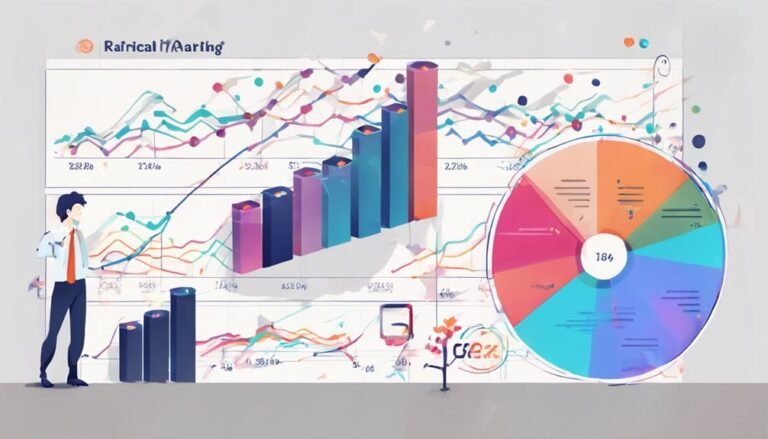What Strategies Help Reduce Customer Churn in Financial Services?
To reduce customer churn in financial services, you must focus on customer segmentation, personalized communication, and enhanced customer support. By understanding customer behavior and needs, implementing tailored messaging, and providing thorough training and personalized assistance, you can enhance engagement and boost satisfaction levels. Loyalty programs, data analytics, proactive feedback mechanisms, competitive pricing, and continuous product innovation are also crucial strategies. These components work together to reduce churn rates and improve customer retention. Each strategy plays a significant role in fostering long-term relationships and increasing loyalty.
Key Takeaways
- Implement personalized communication strategies for engagement and loyalty.
- Develop customer segmentation based on behavior, needs, and demographics.
- Offer proactive feedback mechanisms for continuous improvement and loyalty.
- Utilize data analytics for predictive modeling and targeted marketing strategies.
- Create strategic loyalty programs with gamification and exclusive benefits.
Customer Segmentation
To effectively reduce customer churn in financial services, segmenting customers based on their behavior and needs is vital. Behavioral targeting plays an important role in understanding why customers leave or stay with a financial institution. By analyzing customer behavior such as transaction frequency, account activity, and interaction with the services offered, you can tailor retention strategies that address specific needs and pain points. This data-driven approach allows for targeted interventions that are more likely to resonate with customers, ultimately leading to improved customer retention rates.
In addition to behavioral targeting, demographic analysis is also essential in customer segmentation. Understanding the different demographics within your customer base enables you to create personalized strategies that cater to specific groups. By considering factors such as age, income level, and location, you can further refine your client engagement efforts. This personalized approach shows customers that you understand their unique needs and can provide tailored solutions, fostering stronger relationships and increasing loyalty. By combining behavioral targeting with demographic analysis, you can create a thorough customer segmentation strategy that effectively reduces churn in financial services.
Personalized Communication
To reduce customer churn in financial services, you must implement tailored messaging strategies, customized content delivery, and individualized service approaches.
By personalizing communication based on customer preferences and behaviors, you can enhance engagement and loyalty.
This data-driven approach can greatly increase customer retention rates and overall satisfaction levels.
Tailored Messaging Strategies
Implementing customized messaging strategies in financial services can greatly enhance customer engagement and retention rates. By utilizing behavioral targeting and A/B testing, financial institutions can tailor their messages based on individual customer behaviors and preferences.
Segmented campaigns allow for the delivery of specific messages to different customer segments, ensuring that each group receives relevant information. Dynamic content further personalizes the messaging experience by adapting to customer interactions in real-time.
These strategies not only increase the effectiveness of communication but also foster a sense of connection and understanding between the financial institution and its customers. Through personalized messaging, financial services can build stronger relationships with customers, ultimately reducing churn rates and improving overall satisfaction levels.
Customized Content Delivery
Customized content delivery plays a pivotal role in enhancing customer engagement and retention within financial services, enabling tailored communication strategies to cater to individual preferences and behaviors effectively.
- Behavioral Insights: By analyzing customer behavior, financial institutions can create content that resonates with specific needs and preferences.
- Content Personalization: Tailoring content based on demographics, past interactions, and preferences helps in creating a more personalized customer experience.
- Predictive Analytics: Leveraging data analytics to predict future needs and behaviors allows for proactive content delivery strategies.
- Omnichannel Integration: Ensuring consistent and personalized content across all communication channels helps in reinforcing the customer relationship and increasing engagement.
Individualized Service Approaches
Individualized service approaches in financial services, particularly through personalized communication strategies, are pivotal for enhancing customer satisfaction and loyalty.
Service customization allows financial institutions to tailor their offerings to meet the unique needs of each customer. By providing individualized experiences, such as personalized recommendations based on transaction history or targeted promotions aligned with specific financial goals, companies can foster stronger connections with their clients.
Research indicates that customers are more likely to remain loyal to a financial services provider that offers personalized interactions and understands their preferences. Effective personalized communication not only reduces churn but also increases customer lifetime value, as satisfied clients are more inclined to engage in additional services and refer others to the institution.
Enhanced Customer Support
To enhance customer support in financial services, a holistic approach integrating advanced technology and personalized interactions is crucial. This approach guarantees that customers receive the assistance they need promptly and effectively. Here are some strategies to elevate customer support:
- Training Programs: Implement thorough training programs for customer support representatives to boost their product knowledge, communication skills, and problem-solving abilities.
- Technology Solutions: Utilize cutting-edge technology tools such as chatbots, AI-driven analytics, and CRM systems to streamline customer interactions and provide timely solutions.
- Personalized Interactions: Encourage customer support agents to engage in tailored interactions with customers, addressing their specific needs and concerns empathetically.
- Feedback Mechanisms: Establish feedback mechanisms to gather insights from customers about their support experiences, enabling continuous improvement in service delivery.
Loyalty Programs
Rewarding loyal customers is a fundamental aspect of reducing churn in financial services. Personalized offers and perks tailored to individual customer needs can greatly boost retention rates.
Continuous engagement efforts through loyalty programs can foster long-term relationships and enhance customer satisfaction.
Rewarding Loyal Customers
In establishing loyalty programs within financial services, a strategic approach that aligns incentives with customer preferences can greatly reduce customer churn rates. When it comes to rewarding loyal customers, consider the following key strategies:
- Tiered Rewards System: Offer different levels of rewards based on the customer's loyalty or engagement with your services.
- Personalized Rewards: Tailor rewards to individual preferences and behaviors to increase their perceived value.
- Exclusive Benefits: Provide exclusive perks such as early access to new products or priority customer service to enhance loyalty.
- Points-Based Systems: Implement a points system where customers can earn points for every interaction and redeem them for rewards, encouraging continued engagement.
Personalized Offers and Perks
Considering the impact of personalized offers and perks within loyalty programs in financial services, a data-driven approach to understanding customer preferences and behaviors is essential for reducing customer churn rates.
By analyzing customer data, financial institutions can tailor exclusive promotions and special discounts to individual clients, increasing their loyalty and satisfaction. Personalized offers can range from discounted rates on specific services to customized rewards based on spending patterns.
These tailored perks not only incentivize customers to stay but also enhance their overall experience with the institution.
Implementing a targeted approach to loyalty programs, backed by data insights, enables financial service providers to build stronger relationships with their customers, ultimately leading to higher retention rates and reduced churn.
Continuous Engagement Efforts
To enhance customer loyalty and reduce churn rates in financial services, maintaining continuous engagement efforts through strategic loyalty programs is essential. Implementing behavioral nudges can guide customers towards desired actions, while digital interactions provide personalized experiences.
Utilizing gamification tactics within loyalty programs can make the customer journey more interactive and enjoyable. Engagement platforms offer a centralized space for customers to track rewards, access exclusive content, and participate in community activities.
Data Analytics
Utilizing advanced data analytics techniques can provide valuable insights into customer behavior and preferences, essential for reducing customer churn in financial services. By leveraging predictive modeling and customer behavior analysis, financial institutions can make data-driven decisions and implement targeted marketing strategies to enhance customer retention. The table below highlights the key benefits of incorporating data analytics into customer churn reduction strategies:
| Data Analytics Benefits | Description |
|---|---|
| Predictive Modeling | Utilizing historical data to forecast future customer behavior, allowing for proactive measures. |
| Customer Behavior Analysis | Understanding how customers interact with financial products to tailor offerings effectively. |
| Data-Driven Decisions | Making informed decisions based on concrete data insights rather than intuition or guesswork. |
| Targeted Marketing Strategies | Crafting personalized marketing campaigns that resonate with specific customer segments. |
Proactive Feedback Mechanisms
Implementing proactive feedback mechanisms enhances customer engagement and provides valuable insights for reducing churn in financial services. By actively seeking feedback from customers, financial institutions can identify issues early on and take proactive interventions to address them before they escalate.
Here are four key ways proactive feedback mechanisms can help reduce customer churn:
- Early Warning Signals: Proactive feedback mechanisms can serve as early warning signals for potential issues that may lead to customer dissatisfaction or churn. By analyzing feedback data, financial service providers can detect patterns indicating a higher likelihood of churn.
- Proactive Intervention: Armed with insights from feedback mechanisms, financial institutions can proactively intervene to resolve customer concerns. This could involve reaching out to dissatisfied customers, offering personalized solutions, or addressing issues before they become critical.
- Continuous Improvement: Feedback mechanisms enable continuous improvement by gathering insights into customer preferences, pain points, and satisfaction levels. This data can guide strategic decision-making and help in enhancing overall customer experience.
- Building Customer Loyalty: By actively listening to customer feedback and taking swift actions, financial institutions can build trust and loyalty among customers. This, in turn, can help in reducing churn rates and fostering long-term relationships.
Competitive Pricing Strategies
Competitive pricing strategies play a pivotal role in shaping customer behavior and influencing market dynamics within the financial services industry. Pricing optimization is vital for financial institutions to remain competitive and retain customers. By strategically adjusting prices based on market trends, customer preferences, and competitor pricing, financial firms can attract new customers and retain existing ones. Market positioning is also key, as pricing strategies need to align with the value proposition offered by the institution to make sure that customers perceive the services as worth the cost.
Effective pricing strategies involve a deep understanding of customer segments and their willingness to pay for various services. Analyzing data on customer behavior and market trends allows financial institutions to set prices that are both competitive and profitable. By continuously monitoring and adjusting pricing strategies, firms can stay ahead of the competition and reduce customer churn. Additionally, pricing strategies should be dynamic to adapt to changing market conditions and customer needs.
Continuous Product Innovation
To drive sustainable growth and stay ahead in the financial services industry, continuous product innovation is essential. Embracing innovation adoption and leveraging it effectively can help your organization differentiate itself in the market. Here are some key strategies to ponder:
- Customer-Centric Approach:
By focusing on understanding customer needs and pain points, you can tailor your product innovations to meet their specific requirements. This customer-centric approach guarantees that your offerings remain relevant and valuable.
- Agile Development Processes:
Implementing agile methodologies allows for quicker iterations and enhancements to your products based on real-time feedback. This agility in development enables you to adapt swiftly to changing market dynamics.
- Cross-Functional Collaboration:
Encouraging collaboration between different teams such as product development, marketing, and customer service fosters a holistic approach to innovation. This cross-functional collaboration can lead to more innovative and integrated product solutions.
- Data-Driven Decision Making:
Utilizing data analytics to drive product innovation decisions can help identify trends, customer preferences, and areas for improvement. By making data-driven decisions, you can make sure that your product innovations resonate with your target audience and contribute to market differentiation.
Regulatory Compliance
Maintaining regulatory compliance in the financial services sector is essential for ensuring operational integrity and building trust with stakeholders. Compliance monitoring plays an important role in this process, helping financial institutions adhere to laws, regulations, and guidelines set forth by governing bodies. By keeping a close eye on regulatory updates, organizations can proactively adjust their practices to stay in line with evolving requirements, reducing the risk of non-compliance penalties and reputational damage.
Effective compliance monitoring involves continuously reviewing and updating internal processes, policies, and controls to align with the latest regulatory standards. This proactive approach not only mitigates legal risks but also demonstrates a commitment to ethical business practices, fostering trust among customers and investors. Additionally, by staying abreast of regulatory updates, financial institutions can adapt swiftly to changes, maintaining a competitive edge in the market while safeguarding their reputation.
Conclusion
You've implemented all the right strategies to reduce customer churn in financial services. Your data-driven approach, personalized communication, and proactive feedback mechanisms have surely made an impact.
But alas, the irony lies in the fact that despite your best efforts, some customers will still slip through the cracks. Remember, in the fast-paced world of finance, change is inevitable.
Stay vigilant, adapt, and continue to innovate to stay ahead of the game.







